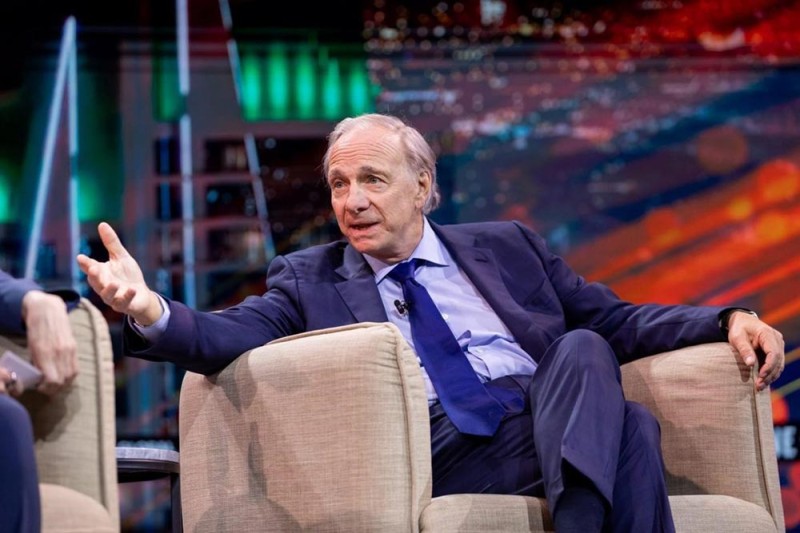
从表面上看,美国经济形势似乎相当不错。华尔街欣欣向荣,硅谷潜力蓬勃,失业率保持稳定,国内生产总值(GDP)也在增长。一派向好景象,对吗?瑞·达利欧却认为,事实并非如此。他指出,当前美国经济内部差异巨大,已不能再被“作为一个整体”来看待。
随着美国对其生产力最高的科技行业的依赖日益加深,经济动态正变得愈发复杂。尽管华尔街已开始私下议论估值“泡沫”,但达利欧警告称,更广泛地看,大多数劳动者的前景如今都与一个相对狭小的行业领域紧密捆绑。
“我认为关键问题在于,如今不能再把美国当作一个整体来看待,”这位桥水基金创始人周一在利雅得举行的《财富》全球论坛(Fortune Global Forum)上表示。他补充道:“你必须从极其巨大的差异本身以及这些差异如何被处理的角度,来看待所有问题。”
他解释道:“比如说,如果你关注人工智能领域,真正引领这个领域的大约是300万人——占人口的1%——再加上他们周围约5%或10%的相关从业者,这就构成了一个全世界都依赖的领域。”
“而另一方面,还有占总人口60%的底层群体。”
达利欧的看法与穆迪公司(Moody's)本月早些时候发布的研究报告相呼应。该分析显示,美国有22个州的经济正在收缩——实际上已陷入衰退。与此同时,仅有16个州实现经济增长,另有13个州被归类为“停滞不前”。尽管如此,对美国GDP贡献最大的加利福尼亚州、德克萨斯州和纽约州均表现良好,从而推动了美国整体经济的增长。
事实上,穆迪公司首席经济学家马克·赞迪(Mark Zandi)告诉《财富》杂志,整个美国经济的未来与两个州的增长紧密相连:加利福尼亚州和纽约州。加州的重要性不言而喻,因为它是科技巨头的家园;而纽约州则作为金融合作伙伴,受益于西海岸的创新成果。
达利欧继续说道:“想想看,60%的美国人口阅读水平低于六年级程度。这很严峻,并且导致他们生产力低下,正因为这些情况,你产生了一种依赖性,一种极端的依赖。”
根据美国国家扫盲研究所(National Literacy Institute)的数据,54%的美国成年人阅读水平相当于六年级以下,64%的美国四年级学生阅读不熟练。
“这是泡沫吗?不是泡沫吗?我们会就此辩论,最终也会找到答案,但无论如何,这本身就是一个问题。”
应对之道
过去几十年间,美国乃至全球许多发达国家的财富不平等现象日益加剧。自2020年以来,财富明显向收入阶梯顶端的人群集中。
根据美联储(Fed)的数据,在2020年至2025年间,美国底层50%人口的总财富增长了略高于2万亿美元。相比之下,根据最新估算,顶层0.1%人群持有的资产几乎翻了一番,从12.17万亿美元增至22.33万亿美元。
达利欧问道:“问题是,当(政策制定者)资金不足,又面临如此巨大的财富鸿沟时,他们该怎么办?”
他继续说道,他对政府人士的建议是,要认识到财富再分配是一个“非常艰难的决定”,对国家的整体生产力影响巨大。“要把它当作一个机制性问题,而不是意识形态问题来处理,”他补充道。“在此基础上,你面临的选择是由谁来支付成本,以及你将如何操作。”
政府有充分理由对向拥有大量可支配收入的人群增税感到紧张,毕竟,他们可能是当前唯一在消费的群体。同样来自穆迪公司的分析显示,以100个基点(相当于1999年第四季度的支出水平)为基准,截至本文撰写时,美国最高收入群体——即收入处于96.6%至100%分位的人群——已将支出增加至约170个基点。
相反,中低收入人群的支出仅增至约120个基点。尽管如此,从2020年第四季度到最近的数据,消费者价格指数(CPI)的走势几乎与此完全一致,这意味着支出增长仅仅是与通胀持平。
“美国经济在很大程度上是由富裕阶层推动的,”赞迪指出。“只要他们持续消费,经济就应该能避免衰退,但如果他们变得更为谨慎,无论出于何种原因,经济都会面临大问题。”(*)
译者:冯丰
审校:夏林
从表面上看,美国经济形势似乎相当不错。华尔街欣欣向荣,硅谷潜力蓬勃,失业率保持稳定,国内生产总值(GDP)也在增长。一派向好景象,对吗?瑞·达利欧却认为,事实并非如此。他指出,当前美国经济内部差异巨大,已不能再被“作为一个整体”来看待。
随着美国对其生产力最高的科技行业的依赖日益加深,经济动态正变得愈发复杂。尽管华尔街已开始私下议论估值“泡沫”,但达利欧警告称,更广泛地看,大多数劳动者的前景如今都与一个相对狭小的行业领域紧密捆绑。
“我认为关键问题在于,如今不能再把美国当作一个整体来看待,”这位桥水基金创始人周一在利雅得举行的《财富》全球论坛(Fortune Global Forum)上表示。他补充道:“你必须从极其巨大的差异本身以及这些差异如何被处理的角度,来看待所有问题。”
他解释道:“比如说,如果你关注人工智能领域,真正引领这个领域的大约是300万人——占人口的1%——再加上他们周围约5%或10%的相关从业者,这就构成了一个全世界都依赖的领域。”
“而另一方面,还有占总人口60%的底层群体。”
达利欧的看法与穆迪公司(Moody's)本月早些时候发布的研究报告相呼应。该分析显示,美国有22个州的经济正在收缩——实际上已陷入衰退。与此同时,仅有16个州实现经济增长,另有13个州被归类为“停滞不前”。尽管如此,对美国GDP贡献最大的加利福尼亚州、德克萨斯州和纽约州均表现良好,从而推动了美国整体经济的增长。
事实上,穆迪公司首席经济学家马克·赞迪(Mark Zandi)告诉《财富》杂志,整个美国经济的未来与两个州的增长紧密相连:加利福尼亚州和纽约州。加州的重要性不言而喻,因为它是科技巨头的家园;而纽约州则作为金融合作伙伴,受益于西海岸的创新成果。
达利欧继续说道:“想想看,60%的美国人口阅读水平低于六年级程度。这很严峻,并且导致他们生产力低下,正因为这些情况,你产生了一种依赖性,一种极端的依赖。”
根据美国国家扫盲研究所(National Literacy Institute)的数据,54%的美国成年人阅读水平相当于六年级以下,64%的美国四年级学生阅读不熟练。
“这是泡沫吗?不是泡沫吗?我们会就此辩论,最终也会找到答案,但无论如何,这本身就是一个问题。”
应对之道
过去几十年间,美国乃至全球许多发达国家的财富不平等现象日益加剧。自2020年以来,财富明显向收入阶梯顶端的人群集中。
根据美联储(Fed)的数据,在2020年至2025年间,美国底层50%人口的总财富增长了略高于2万亿美元。相比之下,根据最新估算,顶层0.1%人群持有的资产几乎翻了一番,从12.17万亿美元增至22.33万亿美元。
达利欧问道:“问题是,当(政策制定者)资金不足,又面临如此巨大的财富鸿沟时,他们该怎么办?”
他继续说道,他对政府人士的建议是,要认识到财富再分配是一个“非常艰难的决定”,对国家的整体生产力影响巨大。“要把它当作一个机制性问题,而不是意识形态问题来处理,”他补充道。“在此基础上,你面临的选择是由谁来支付成本,以及你将如何操作。”
政府有充分理由对向拥有大量可支配收入的人群增税感到紧张,毕竟,他们可能是当前唯一在消费的群体。同样来自穆迪公司的分析显示,以100个基点(相当于1999年第四季度的支出水平)为基准,截至本文撰写时,美国最高收入群体——即收入处于96.6%至100%分位的人群——已将支出增加至约170个基点。
相反,中低收入人群的支出仅增至约120个基点。尽管如此,从2020年第四季度到最近的数据,消费者价格指数(CPI)的走势几乎与此完全一致,这意味着支出增长仅仅是与通胀持平。
“美国经济在很大程度上是由富裕阶层推动的,”赞迪指出。“只要他们持续消费,经济就应该能避免衰退,但如果他们变得更为谨慎,无论出于何种原因,经济都会面临大问题。”(*)
译者:冯丰
审校:夏林
On the surface, the going looks pretty good in the American economy. Wall Street is roaring, Silicon Valley is booming with potential, unemployment is fairly steady, and GDP is on the rise. A healthy picture, right? Wrong, says Ray Dalio. There is now so much variation in the U.S. economy that it can no longer be looked at “as a whole.”
The dynamic is growing increasingly complex as the nation is becoming more reliant on its most productive industry: technology. While Wall Street has begun to mutter the world “bubble” in relation to valuations, Dalio warns that more widely, the prospects of the majority of workers are now tied to those in a relatively small sector.
“I think the issue is very much that you can't look at the U.S. as a whole nowadays,” the Bridgewater Associates founder said at the Fortune Global Forum in Riyadh on Monday. He added: “You have to look at everything in terms of the very, very big differences and how those differences are handled.”
He explained: “If you're looking at, let's say, the AI world, and really what amounts to about 3 million people---1% of the population---leading, and then ... the 5% or 10% around them, you have one world that the whole world is dependent on.
“And then you have the bottom 60% of the population.”
Dalio's take echoes research released by Moody's earlier this month. According to the analysis, 22 U.S. states are seeing their economies contract---effectively in a recession. Meanwhile, just 16 are seeing economic growth, while 13 are classified as “treading water.” That said, the states contributing the most to U.S. GDP---California, Texas, and New York---are all in the clear, pushing the overall growth of the country into the green as a result.
Indeed, Moody's chief economist Mark Zandi told Fortune the future of the entire U.S. economy is tied to the growth in two states: California and New York. California, of course, because it is home to Big Tech and New York as the financial partner benefiting from its West Coast innovations.
Dalio continued: “Consider this, 60% of the American population has below sixth-grade reading level. That's tough, and with that they′rebecomingthey′rebecoming unproductive, and because of those things you have a dependency, an extreme dependency.”
According to the National Literacy Institute, 54% of U.S. adults read below the equivalent of a sixth-grade level, and 64% of our country's fourth-graders do not read proficiently.
“Is it a bubble? Is it not a bubble? We will debate that, and we'll eventually find out, but in any case it is in itself an issue.”
Dealing with the problem
Wealth inequality in the U.S.---and indeed in many of the globe's developed nations---has increasingly diverged over the past few decades. Since 2020 the shift in wealth has been heavily toward those at the upper end of the income ladder.
According to data from the Fed, between 2020 and 2025 the wealth of the entire bottom 50% of the U.S. population has increased by a little over $2 trillion. By contrast, the assets held by the top 0.1% have nearly doubled from $12.17 trillion to $22.33 trillion, per latest estimates.
“The question is, what do policymakerspolicymakers do when you don't have enough money and you have this big wealth gap?” Dalio asked.
His advice to those in government, he continued, would be to recognize that redistributing wealth is a “very difficult decision to make” with huge implications for the productivity of a nation as a whole. “Deal with it as a mechanical, not an ideological thing,” he added. “And on that basis, what you have is a choice of who's gonna pay and how are you going to do this?”
Administrations may be rightly nervous about taxing those with larger pots of disposable income, after all, they may be the only ones spending. Analysis, again from Moody's, showed that working from a basis point of 100 (equivalent to spending levels in Q4 of 1999), the top U.S. earners---those in the 96.6% to 100% category---have increased their spending to around 170 basis points, at the time of writing.
Conversely, low- and middle-income earners have increased their spending to around 120 basis points. That being said, the consumer price index has followed an almost identical trajectory from Q4 2020 to the most recent figures, meaning spending is merely in line with inflation.
“The U.S. economy is being largely powered by the well-to-do,” Zandi noted. “As long as they keep spending, the economy should avoid recession, but if they turn more cautious, for whatever reason, the economy has a big problem.”

